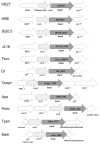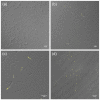Role of Archaeal HerA Protein in the Biology of the Bacterium Thermus thermophilus
- PMID: 28448436
- PMCID: PMC5448004
- DOI: 10.3390/genes8050130
Role of Archaeal HerA Protein in the Biology of the Bacterium Thermus thermophilus
Abstract
Intense gene flux between prokaryotes result in high percentage of archaeal genes in the genome of the thermophilic bacteria Thermus spp. Among these archaeal genes a homolog to the Sulfolobus spp. HerA protein appears in all of the Thermus spp. strains so far sequenced (HepA). The role of HepA in Thermus thermophilus HB27 has been analyzed using deletion mutants, and its structure resolved at low resolution by electron microscopy. Recombinant HepA shows DNA-dependent ATPase activity and its structure revealed a double ring, conically-shaped hexamer with an upper diameter of 150 Å and a bottom module of 95 Å. A central pore was detected in the structure that ranges from 13 Å at one extreme, to 30 Å at the other. Mutants lacking HepA show defective natural competence and DNA donation capability in a conjugation-like process termed "transjugation", and also high sensitivity to UV and dramatic sensitivity to high temperatures. These data support that acquisition of an ancestral archaeal HerA has been fundamental for the adaptation of Thermus spp. to high temperatures.
Keywords: DNA repair; HerA; Thermus; hexameric ATPase; lateral gene transfer; transformation; transjugation.
Conflict of interest statement
The authors declare no conflict of interest. The founding sponsors had no role in the design of the study; in the collection, analyses, or interpretation of data; in the writing of the manuscript, and in the decision to publish the results.
Figures








Similar articles
-
Resistance to UV Irradiation Caused by Inactivation of nurA and herA Genes in Thermus thermophilus.J Bacteriol. 2018 Jul 25;200(16):e00201-18. doi: 10.1128/JB.00201-18. Print 2018 Aug 15. J Bacteriol. 2018. PMID: 29844033 Free PMC article.
-
Characterization of DNA transport in the thermophilic bacterium Thermus thermophilus HB27.FEBS J. 2006 Sep;273(18):4210-8. doi: 10.1111/j.1742-4658.2006.05416.x. FEBS J. 2006. PMID: 16939619
-
The transjugation machinery of Thermus thermophilus: Identification of TdtA, an ATPase involved in DNA donation.PLoS Genet. 2017 Mar 10;13(3):e1006669. doi: 10.1371/journal.pgen.1006669. eCollection 2017 Mar. PLoS Genet. 2017. PMID: 28282376 Free PMC article.
-
Unconventional lateral gene transfer in extreme thermophilic bacteria.Int Microbiol. 2011 Dec;14(4):187-99. doi: 10.2436/20.1501.01.148. Int Microbiol. 2011. PMID: 22569756 Review.
-
Shuffling genes around in hot environments: the unique DNA transporter of Thermus thermophilus.FEMS Microbiol Rev. 2009 May;33(3):611-26. doi: 10.1111/j.1574-6976.2008.00160.x. Epub 2009 Jan 16. FEMS Microbiol Rev. 2009. PMID: 19207744 Review.
Cited by
-
Phage defence loci of Streptococcus thermophilus-tip of the anti-phage iceberg?Nucleic Acids Res. 2024 Oct 28;52(19):11853-11869. doi: 10.1093/nar/gkae814. Nucleic Acids Res. 2024. PMID: 39315705 Free PMC article.
-
The PulE ATPase is required for twitching motility and DNA donation during Thermus thermophilus transjugation.Int Microbiol. 2025 Jun;28(5):1047-1055. doi: 10.1007/s10123-024-00598-4. Epub 2024 Sep 26. Int Microbiol. 2025. PMID: 39325340
-
Structural and DNA end resection study of the bacterial NurA-HerA complex.BMC Biol. 2023 Feb 24;21(1):42. doi: 10.1186/s12915-023-01542-0. BMC Biol. 2023. PMID: 36829173 Free PMC article.
-
Differential requirement for RecFOR pathway components in Thermus thermophilus.Environ Microbiol Rep. 2024 Jun;16(3):e13269. doi: 10.1111/1758-2229.13269. Environ Microbiol Rep. 2024. PMID: 38822640 Free PMC article.
-
Deletion of the primase-polymerases encoding gene, located in a mobile element in Thermus thermophilus HB27, leads to loss of function mutation of addAB genes.Front Microbiol. 2022 Dec 1;13:1005862. doi: 10.3389/fmicb.2022.1005862. eCollection 2022. Front Microbiol. 2022. PMID: 36532486 Free PMC article.
References
-
- Omelchenko M.V., Wolf Y.I., Gaidamakova E.K., Matrosova V.Y., Vasilenko A., Zhai M., Daly M.J., Koonin E.V., Makarova K.S. Comparative genomics of thermus thermophilus and deinococcus radiodurans: Divergent routes of adaptation to thermophily and radiation resistance. BMC Evol. Biol. 2005;5:57. doi: 10.1186/1471-2148-5-57. - DOI - PMC - PubMed
-
- Iyer L.M., Makarova K.S., Koonin E.V., Aravind L. Comparative genomics of the ftsk—HerA superfamily of pumping atpases: Implications for the origins of chromosome segregation, cell division and viral capsid packaging. Nucleic Acids Res. 2004;32:5260–5279. doi: 10.1093/nar/gkh828. - DOI - PMC - PubMed
LinkOut - more resources
Full Text Sources
Other Literature Sources
Molecular Biology Databases
Miscellaneous

